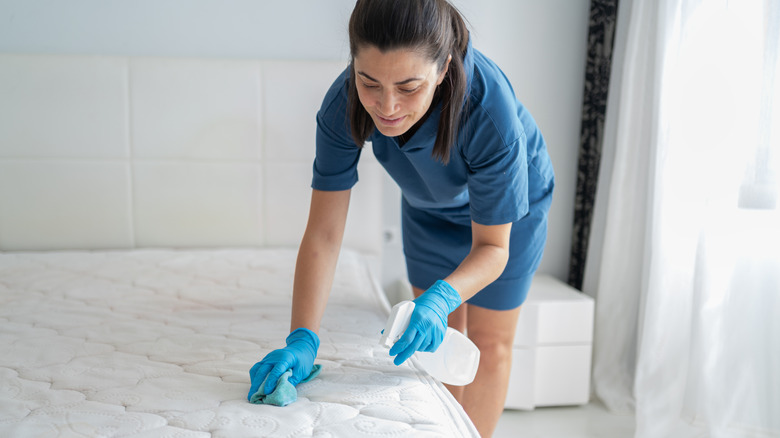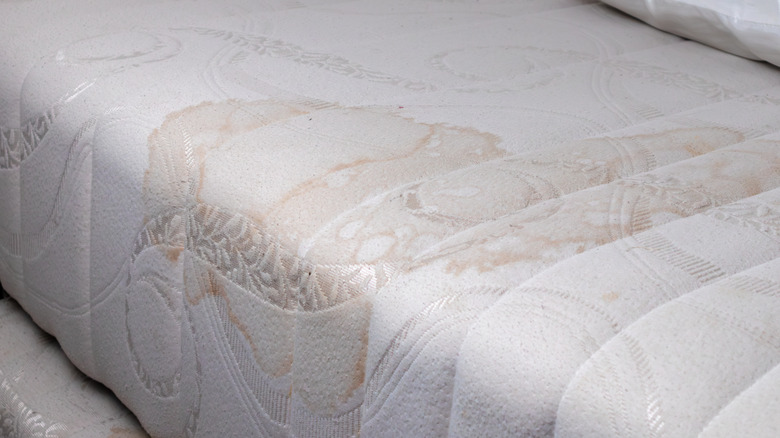The 3 Most Common Types Of Mattress Stains (& How To Best Remove Them)
Mess happens, and that new mattress is not immune when it comes to the stains that can occur during your day. In fact, mattress stains are common, and they can happen even when it feels like you're taking all the precautions to keep your mattress looking fresh. As a result, if you've found yourself face to face with an eyesore every time you change your sheets, you may be wondering the best way to remove mattress stains — and it starts off by learning to identify the culprit.
When it comes to fabrics, there are three main types of stains to be aware of: oil-based, tannin-based, and protein-based. Each of these are caused by a different source, and, because they have different compositions, you'll want a targeted approach for each type of stain. After all, how you treat an oil-based stain from your nightly lotion routine can be different from how you tackle the mark left by the coffee you accidentally spilled in bed last week.
On the bright side, once you learn what to look for when identifying a stain and understand what causes that left behind color, cleaning can be as simple as choosing the right products and applying a little bit of elbow grease. Just keep in mind that it may not always be possible to entirely remove those older, dried stains. As a result, immediately target stains when they happen if possible, even if you save deep cleaning your bedroom for another day.
Identifying and removing oil-based stains
One of the most common types of stains you'll encounter on your mattress are oil-based stains. If you eat while sitting in bed, your mattress can develop oil-based stains as the result of a variety of ingredients, from condiments like mayonnaise to butter. However, food isn't the only source of an oil-based stain on your mattress. Instead, these stains may also appear from deodorant, hair oil, ointments, lotion, and body oils.
Oil-based stains can be yellow or brown, and they stain deep within the fabric of your mattress. Because they develop as a result of oils, water-based cleaners won't work on removing these stains. Instead, you'll need to choose a cleaner that's designed with oil-based stains in mind, and you may need to treat the area more than once.
If you've identified oil as the cause of your mattress stain, start by pre-treating the area. Starting off the cleaning process with a round of stain treatment can help with deep-set stains that need more than a surface level cleaning. Instead of a commercial product, you can also use a diluted vinegar solution (1/2 part water to 1/2 part vinegar) at this step to start breaking down the oils. Then, carefully blot away the moisture to lift the stain. If it's particularly stubborn, you may want to add a few drops of dish soap if it's safe for your mattress material. To finish off any lingering oil, add baking soda to the site of the stain and allow it to sit before vacuuming any leftover powder.
Identifying and removing tannin-based stains
If you are prone to snacking in bed but an oil-based stain isn't your problem, then you may be dealing with a tannin-based stain. Tannins are chemicals found in a variety of foods and beverages, including some types of tea, fruit, nuts, and chocolate. Coffee and wine can also be sources of tannins. In many cases, you'll find that, like oil-based stains, tannin stains are yellow or brown. However, in the case of fruits or wine, they may take on other colors as well. While the colors may be reminiscent of an oil-based stain, the process of removing that set-in color is far different.
If possible, tannin stains are best removed as soon as the spill happens, especially because you don't want to pre-treat these stains. Use a towel or paper towel to soak up as much of the liquid or spill-source as possible, blotting and not rubbing to help prevent the stain from setting. Then, you'll need to choose the right cleaners to break down the tannin chemicals. Luckily, there's a common household essential that can be handy for removing these stains: hydrogen peroxide. Mix 1 part hydrogen peroxide with 1/2 part dish soap, apply it to the stain and allow it to sit, and then wipe the mixture away with a damp, clean cloth.
For older stains, this method may not work. If you were dealing with clothes or other fabrics, bleach could be helpful in removing those old tannin-based stains. However, bleach is a cleaning agent to avoid using on your mattress, even when it comes to removing stains.
Identifying and removing protein-based stains
The third most common type of mattress stain is a protein-based stain, which can include blood, dairy, sweat, urine, or vomit — all of which you likely don't want a reminder of when stripping your sheets or settling into bed at night. Fortunately, the memories of a sick spell don't have to linger, as treating the yellow, brown, or red stains these instances leave behind can be accomplished. However, much like with tannin-based stains, it's important to act quickly for the best results, as the bleach needed to clean in older stains may not be a useful solution for your mattress.
When attempting to remove a protein-based stain from your mattress, it's important to denature and breakdown the proteins to remove the stain. In many cases, this may require the help of a store-bought enzyme cleaner designed with mattresses in mind. You can also get tough protein soils like blood stains out of your mattress with hydrogen peroxide.
Regardless of how you choose to remove your protein-based stains, one of the most important things to keep in mind is that you shouldn't use hot water. Hot water can cause the stain to set quicker, which can make removal even more difficult. Instead, when wiping down or rinsing your mattress, opt for cold water.



